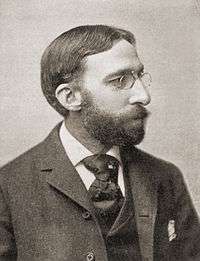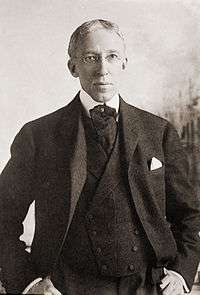Peter S. Grosscup
| Peter Stenger Grosscup | |
|---|---|
 Judge Peter S. Grosscup as he appeared at the time of the 1894 Pullman Strike. | |
| Judge of the United States Court of Appeals for the Seventh Circuit | |
|
In office January 23, 1899 – October 23, 1911 | |
| Nominated by | William McKinley |
| Preceded by | John William Showalter |
| Succeeded by | Samuel Alschuler |
| Judge of the United States District Court for the Northern District of Illinois | |
|
In office December 20, 1892 – February 1, 1899 | |
| Nominated by | Benjamin Harrison |
| Preceded by | Henry Williams Blodgett |
| Succeeded by | Christian Cecil Kohlsaat |
| Personal details | |
| Born |
February 15, 1852 Ashland, Ohio, U.S. |
| Died |
October 1, 1921 (aged 69) On board a ship bound for Southampton |
| Alma mater |
Wittenberg College, A.B. Boston University School of Law, LL.B |
Peter Stenger Grosscup (February 15, 1852 – October 1, 1921) was a United States federal judge. Grosscup is best remembered for having made use of the judicial injunction against strikers in labor disputes, including most notably the leadership of the American Railway Union in the 1894 Pullman Strike.
Biography
Early years
Peter S. Grosscup was born in Ashland, Ohio, on February 15, 1852. Grosscup received an Bachelor of Arts from Wittenberg College in 1872 and a Bachelor of Laws from Boston University School of Law in 1873.
Legal career

He was in private practice in Ashland, Ohio from 1873 to 1875 and was then city solicitor of Ashland until 1881. He returned to private practice in Ashland from 1881 to 1883, and then in Chicago, Illinois until 1892.
On December 12, 1892, Grosscup was nominated by President Benjamin Harrison to a seat on the United States District Court for the Northern District of Illinois vacated by Henry W. Blodgett. Grosscup was confirmed by the United States Senate on December 20, 1892, and received his commission the same day. According to Almont Lindsey's 1942 book The Pullman Strike, Grosscup received this appointment as political payback for a large donation George Pullman made to the Harrison presidential campaign.[1]
According to Almont Lindsey, federal judges Peter Grosscup and William Woods issued the first omnibus injunction against the Pullman railroad strikers in Chicago protecting 22 railroads on July 2, 1894. This innovative use of a federal injunction charged unnamed strikers with conspiracy for interfering with interstate commerce and the mails thus putting the federal courts at the disposal of corporations to break strikes.[2] The July 3, 1894 New York Times called the injunction a "Gatling gun on paper."
On January 18, 1899, President William McKinley nominated Grosscup for elevation to a seat on the United States Court of Appeals for the Seventh Circuit vacated by John William Showalter. Grosscup was again confirmed by the United States Senate on January 23, 1899, and received his commission the same day. He served in that capacity until his resignation from the bench on October 23, 1911.
Death and legacy
Peter S. Grosscup died October 1, 1921 on board a ship bound for Southampton. He was 69 years old at the time of his death.
References
- Footnotes
- Sources
- Peter Stenger Grosscup at the Biographical Directory of Federal Judges, a public domain publication of the Federal Judicial Center.
External links
- "History of the Federal Judiciary: The Debs Case: Labor, Capital, and the Federal Courts of the 1890s: Biographies: Peter S. Grosscup (1852–1921) ," Federal Judicial Center, www.fjc.gov
| Legal offices | ||
|---|---|---|
| Preceded by Henry Williams Blodgett |
Judge of the U.S. District Court for the Northern District of Illinois December 20, 1892 – February 1, 1899 |
Succeeded by Christian Cecil Kohlsaat |
| Preceded by John William Showalter |
Judge of the United States Court of Appeals for the Seventh Circuit 1899–1911 |
Succeeded by Samuel Alschuler |